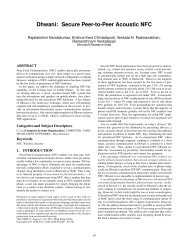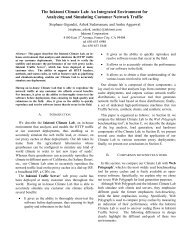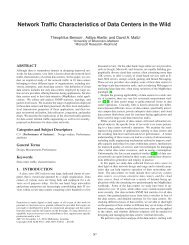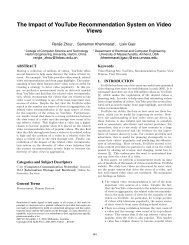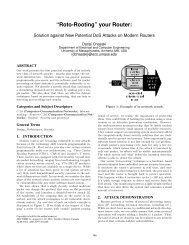ICTCP: Incast Congestion Control for TCP in Data Center ... - Sigcomm
ICTCP: Incast Congestion Control for TCP in Data Center ... - Sigcomm
ICTCP: Incast Congestion Control for TCP in Data Center ... - Sigcomm
You also want an ePaper? Increase the reach of your titles
YUMPU automatically turns print PDFs into web optimized ePapers that Google loves.
Goodput (Mbps) with a fixed total amount<br />
1000<br />
900<br />
800<br />
700<br />
600<br />
500<br />
400<br />
300<br />
200<br />
100<br />
0<br />
<strong>TCP</strong> total data=2M<br />
<strong>TCP</strong> total data=8M<br />
<strong>IC<strong>TCP</strong></strong> total data=2M<br />
<strong>IC<strong>TCP</strong></strong> total data=8M<br />
4 8 12 16 20 24 28 32 36 40 44 48<br />
Number of senders <strong>in</strong> parallel<br />
Figure 9: Goodput of <strong>IC<strong>TCP</strong></strong> (with m<strong>in</strong>imal<br />
receive w<strong>in</strong>dow at 2MSS) and <strong>TCP</strong> under the<br />
case that the total data amount from all send<strong>in</strong>g<br />
servers is a fixed value<br />
Ratio of rounds with <strong>TCP</strong> timeout(%)<br />
100<br />
90<br />
80<br />
70<br />
60<br />
50<br />
40<br />
30<br />
20<br />
10<br />
0<br />
<strong>TCP</strong> total data=2M<br />
<strong>TCP</strong> total data=8M<br />
<strong>IC<strong>TCP</strong></strong> total data=2M<br />
<strong>IC<strong>TCP</strong></strong> total data=8M<br />
4 8 12 16 20 24 28 32 36 40 44 48<br />
Number of senders <strong>in</strong> parallel<br />
Figure 10: Ratio of timeout <strong>for</strong> <strong>IC<strong>TCP</strong></strong> (with<br />
m<strong>in</strong>imal receive w<strong>in</strong>dow at 2MSS) and <strong>TCP</strong> under<br />
the case that the total data amount from all<br />
send<strong>in</strong>g servers is a fixed value<br />
9 and 10. From Figure 9 we observe that the number<br />
of send<strong>in</strong>g servers to trigger <strong>in</strong>cast congestion is close<br />
<strong>for</strong> 2M and 8M bytes total traffic respectively. <strong>IC<strong>TCP</strong></strong><br />
greatly improves the goodput and controls timeout well.<br />
Note that we show the case <strong>for</strong> <strong>IC<strong>TCP</strong></strong> with m<strong>in</strong>imal<br />
receive w<strong>in</strong>dow at 2MSS and skip the case with 1MSS,<br />
as the timeout ratio is aga<strong>in</strong> 0% <strong>for</strong> 1MSS.<br />
6.3 <strong>Incast</strong> with high throughput background<br />
traffic<br />
In previous experiments, we do not explicit generate<br />
long term background traffic <strong>for</strong> <strong>in</strong>cast experiments. In<br />
the third scenario, we generate a long term <strong>TCP</strong> connection<br />
as background traffic to the same receiv<strong>in</strong>g server,<br />
and it occupies 900Mbps be<strong>for</strong>e <strong>in</strong>cast traffic starts.<br />
The goodput and timeout ratio of <strong>TCP</strong> and <strong>IC<strong>TCP</strong></strong><br />
are shown <strong>in</strong> Figure 11 and 12. Compared Figure 11<br />
with Figure 2, the throughput achieved by <strong>TCP</strong> be<strong>for</strong>e<br />
<strong>in</strong>cast congestion is slightly lower. <strong>IC<strong>TCP</strong></strong> also achieves<br />
slightly lower throughput when the number of send<strong>in</strong>g<br />
Goodput (Mbps) with a background <strong>TCP</strong><br />
900<br />
800<br />
700<br />
600<br />
500<br />
400<br />
300<br />
200<br />
100<br />
0<br />
<strong>TCP</strong> data=64kbytes<br />
<strong>TCP</strong> data=128kbytes<br />
<strong>TCP</strong> data=256kbytes<br />
<strong>IC<strong>TCP</strong></strong> data=64kbytes<br />
<strong>IC<strong>TCP</strong></strong> data=128kbytes<br />
<strong>IC<strong>TCP</strong></strong> data=256kbytes<br />
4 8 12 16 20 24 28 32 36 40 44 48<br />
Number of senders <strong>in</strong> parallel<br />
Figure 11: Goodput of <strong>IC<strong>TCP</strong></strong> (with m<strong>in</strong>imal receive<br />
w<strong>in</strong>dow at 2MSS) and <strong>TCP</strong> under the case<br />
with a background long term <strong>TCP</strong> connection<br />
Ratio of rounds with <strong>TCP</strong> timeout(%)<br />
100<br />
90<br />
80<br />
70<br />
60<br />
50<br />
40<br />
30<br />
20<br />
10<br />
0<br />
<strong>TCP</strong> data=64kbytes<br />
<strong>TCP</strong> data=128kbytes<br />
<strong>TCP</strong> data=256kbytes<br />
<strong>IC<strong>TCP</strong></strong> data=64kbytes<br />
<strong>IC<strong>TCP</strong></strong> data=128kbytes<br />
<strong>IC<strong>TCP</strong></strong> data=256kbytes<br />
4 8 12 16 20 24 28 32 36 40 44 48<br />
Number of senders <strong>in</strong> parallel<br />
Figure 12: Ratio of timeout <strong>for</strong> <strong>IC<strong>TCP</strong></strong> (with<br />
m<strong>in</strong>imal receive w<strong>in</strong>dow at 2MSS) and <strong>TCP</strong> under<br />
the case with a background long term <strong>TCP</strong><br />
connection<br />
serves is small. Compar<strong>in</strong>g Figure 12 with Figure 7,<br />
the timeout ratio with <strong>IC<strong>TCP</strong></strong> becomes slightly higher<br />
when there is a high throughput background connection<br />
ongo<strong>in</strong>g. This is because the available bandwidth<br />
becomes smaller and thus the <strong>in</strong>itiation of new connections<br />
is affected. We also obta<strong>in</strong> the experimental results<br />
<strong>for</strong> a background UDP connection at 200Mbps,<br />
and <strong>IC<strong>TCP</strong></strong> also per<strong>for</strong>ms well. We skip the results under<br />
background UDP <strong>for</strong> space limitation.<br />
6.4 Fairness and long term per<strong>for</strong>mance of <strong>IC<strong>TCP</strong></strong><br />
To evaluate the fairness of <strong>IC<strong>TCP</strong></strong> on multiple connections,<br />
we generate 5 <strong>IC<strong>TCP</strong></strong> flows to the same receiv<strong>in</strong>g<br />
server under the same switch. The flows are started<br />
sequentially with 20s <strong>in</strong>terval and 100s duration. The<br />
achieved goodput of those 5 <strong>IC<strong>TCP</strong></strong> flows are shown <strong>in</strong><br />
Figure 13. We observe that the fairness of <strong>IC<strong>TCP</strong></strong> on<br />
multiple connections is very good, and the total goodput<br />
of multiple connections is close to l<strong>in</strong>k capacity at<br />
1Gbps. Note that the goodput here is much larger than<br />
that shown <strong>in</strong> Figure 6, s<strong>in</strong>ce the traffic volume is much



